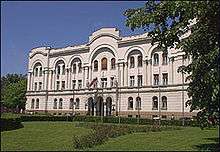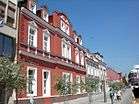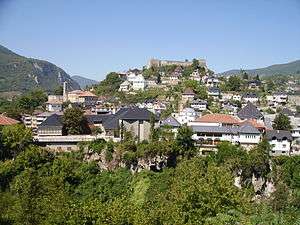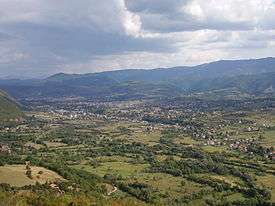Bosanska Krajina

Bosanska Krajina (Serbian Cyrillic: Босанска Крајина, pronounced [bɔ̌sanskaː krâjina]; sometimes translated as Bosnian Frontier) or simply Krajina, is a geographical region, a subregion of Bosnia, in western Bosnia and Herzegovina enclosed by a number of rivers, namely the Sava (north), Glina (northwest), Vrbanja and Vrbas (east and southeast, respectively). The region is also a historic, economic and cultural entity of Bosnia and Herzegovina, famous for its natural beauties and wildlife diversity.[1]
The largest city, and its historical center is Banja Luka. Other cities include Bihać, Cazin, Velika Kladuša, Prijedor, Sanski Most, Gradiška, Kozarska Dubica, Bosanski Novi, Bosanska Krupa, Ključ, Bosanski Petrovac, Kotor Varoš, Šipovo, Mrkonjić Grad, Drvar, Bosansko Grahovo, Gornji Vakuf, Bugojno, Donji Vakuf, Jajce, Kneževo, Bužim, Laktaši, and Čelinac.[1]
Bosanska Krajina has no political borders or political representation in the structure of Bosnia and Herzegovina; however it has a significant cultural and historical identity that was formed through several historic and economic events. The territory of Bosanska Krajina is currently divided between two entities of Bosnia and Herzegovina: Republika Srpska and the Federation of Bosnia and Herzegovina.
Naming
Between the 16th and 19th centuries the territory between the Una and Vrbas rivers was referred by the name Turkish Croatia.[2][3][4] The name was first used consistently by Austrian military topographers who worked in the Austro-Ottoman border commission after the Treaty of Karlowitz of 1699.[2] In the mid 19th century the name Turkish Croatia was replaced by cartographers in favor of Bosanska Krajina.[2]
Geography
The largest city, and its historical center is Banja Luka. Other cities include Bihać, Cazin, Velika Kladuša, Prijedor, Sanski Most, Gradiška, Kozarska Dubica, Bosanski Novi, Bosanska Krupa, Ključ, Bosanski Petrovac, Kotor Varoš, Šipovo, Mrkonjić Grad, Drvar, Bosansko Grahovo, Jajce, Kneževo, Bužim, Laktaši, and Čelinac.
Sub-regions (geographical and historical) include: Bihaćka krajina, Cazinska krajina, Potkozarje, Lijevče, etc.
History
Middle Ages
In the 6th century, today's northwestern Bosnia was part of the Roman province of Dalmatia. It fell under the jurisdiction of the Eastern Roman Empire. Shortly thereafter, Eurasian Avars and their Slavic subjects from central-eastern Europe invaded Dalmatia and settled in what is now Bosnia and Herzegovina. In the 7th century the Serbs and Croats formed principalities initially under the Eastern Roman Empire. It is unclear whether the region was under the Principality of Serbia or Duchy of Croatia in the Early Middle Ages. Fine, Jr. believes that what is today western Bosnia and Herzegovina was part of Croatia, while the rest was divided between Croatia and Serbia.[5] Bosnia proper, called Bosona in the De Administrando Imperio (c. 960), was a "small country" part of the Serbian principality.
Although the borders of the Kingdom of Croatia (925–1102) are unknown, Fine, Jr. believes that it included western Bosnia.[6] Croatia was unified with the Kingdom of Hungary in 1102.
In the 13th and 14th century, a region called Donji Kraji, located in today's southern Bosanska Krajina, was first mentioned as a property of the Diocese of Bosnia and claimed by the Kingdom of Bosnia.
By the 14th century, the Ottoman Empire had significantly expanded into the western Balkans in a series of wars, and the Turkish westward incursions eventually made this region an Ottoman borderland. Jajce had fallen to the Ottomans in 1463, marking the downfall of the Kingdom of Bosnia. The Battle of Krbava Field in 1493 effectively ended the Kingdom of Croatia's persistent hold over the entire region, restricting them to fortified cities.
In the late 15th century, a local Croatian lord (knez) Juraj Mikuličić erected a fort in the village of Bužim near Bihać, fearing the advancing Ottoman army. Mikuličić died in 1495, but the Bužim fort would not pass to Ottoman control until 1576.[7]
Ottoman period
After the crucial 1526 Battle of Mohács and the 1527 election in Cetin, Croatia became part of the Austrian Habsburg Empire. The Ottoman Empire formally established the Eyalet of Bosnia in 1580. The Croatian lands in general were reduced to a fraction of what they encompassed, and only the westernmost parts of today's Bosanska Krajina still resisted the Ottoman rule. Nevertheless, the Ottoman armies preferred to advance towards their targets in the northwest through more easily passable terrain, such as along the river Danube, for example Vienna was first besieged in 1529 after the army had gone through Osijek, Mohács and Buda. The natural obstacles in and around the region, especially at the time, included the rivers Sava, Vrbas, Una and Sana, as well as the mountains such as Plješevica, Šator, Klekovača, Raduša, Grmeč, Kozara and Vlašić.
Turkish incursions expanded further to the north, and Charles of Styria erected a new fortified city of Karlovac in 1579. In 1580 the Turks responded by declaring the Pashaluk of Bosnia which unified all the Sanjaks, including territory in modern-day Croatia. As a result of the wars and border changes, the Catholic Croat population moved north, and was replaced with Orthodox Serbs and Vlachs.[8]
The Bužim fort, under Ottoman control since 1576, was successfully held by the Ottomans in numerous battles (1685, 1686, 1688, 1737) and it was also upgraded (1626, 1834) until their eventual surrender in the 19th century. The building remains to this day as a monument to the Ottoman conquest.[7]
Bihać held out longer than Bužim, and even at one point served as the capital of Croatia. But, in 1592 the Turkish army of about 20,000 under Hasan-pasa Predojević, an Ottoman vizier, attacked and forcefully occupied Bihać. Records show that nearly 2,000 people died in defense of Bihać, and an estimated 800 Croat children from Bihać were sent into servitude in Turkey, to be educated in Islam and become Yenicari. Hasan-pasha Predojević pressed further north into Croatia, but was defeated in the June 1593 Battle of Sisak.
When the Ottoman Empire lost the 1683-1690 War of the Holy League to the Habsburg Monarchy and her allies, and ceded Slavonia and Hungary to Austria at the 1699 Treaty of Karlowitz, the northern and western borders of the Bosnian Province (corresponding to the modern Bosnian borders), became a permanent frontier between the Austrian and Ottoman empires. The Ottomans wanted to turn the tide of warfare to their side, so, opposite to the Habsburg Military Frontier, they formed a Bosnian Frontier which was in the Military Frontiers like, split on captains, each having its own fortifications and military regiments.
The Frontier was further settled by Serbian herders, who served as militia, defending it from hostile incursions and maintaining order, or as medics and workforce for the much needed frontline with the Austrian Empire. Since then, the Serbs formed the majority of the Bosnian Frontier's population.
19th century
In mid-1858, an uprising known as Pecija's First Revolt broke out in the region, resulting from Ottoman pressure against the local Serb populace. It was crushed by December.
The Bosnian Frontier, like the rest of Bosnia and Herzegovina, participated in the 1875 - 1878 Herzegovina Uprising.
World War II

During World War II, Bosanska Krajina was known for its very strong resistance to the Fascist regime. The anti-fascist Partisan movement in the Bosanska Krajina region was more ethnically diverse than in any other part of former Yugoslavia during World War II. In the winter of 1942/1943 the Partisans established the Republic of Bihać in Bosanska Krajina. Soon afterwards, Bosanska Krajina was also the place of historical agreements that have taken place in Jajce and Mrkonjić Grad in 1943, ones that established the Republic of Bosnia and Herzegovina in its current borders, as well as the Federation of Yugoslavia.
During World War II the Ustasha Jasenovac concentration camp was established just across the river Sava from Bosanska Krajina, and many of the region's inhabitants (mainly Serbs, Gypsies and Jews but also some communist Bosnian Muslims and Croats) were killed there. The number of Serbs killed by the Ustaša is between 70,000 and 90,000.
Bosnian War
| 1991 | 1994 | |
|---|---|---|
| Serbs | 625,000 | 875,000 |
| Bosniaks and Croats | 550,000 | 50,000 |
During the 1992-95 Bosnian War, Bosanska Krajina was divided between Republika Srpska, the Republic of Bosnia and Herzegovina, and the Autonomous Province of Western Bosnia. The Serb entity of SAO Bosanska Krajina was established in summer 1991. The region was also a place of concentration camps, including Manjača and Omarska where predominantly Bosniaks were held, tortured, raped, and killed.
| “ | For the past two years, non-Serbs in the Bosanska Krajina area have been "cleansed" through systematic persecution that includes torture, murder, rape, beatings, harassment, de jure discrimination, intimidation, expulsion from homes, confiscation of property, bombing of businesses, dismissal from work, outlawing of all scripts except the Cyrillic in public institutions, and the destruction of cultural objects such as mosques and Catholic churches. | ” | |
| — Human Rights Watch report 1994[10] | |||
Demography
The population of the region numbered almost one million before the war in Bosnia. The ethnic composition of Bosanska Krajina was in 1991 (per census data) 44% Serbs, 40% Bosniaks, 7% Croats, 5% Yugoslavs and 3% others (Romas, Ukrainians, Hungarians and Valachians). The composition of the current population of Bosanska Krajina has dramatically changed since, because of expulsions, forced relocation and emigration during the Bosnian war in 1992-95. Various parts have become less ethnically diverse, mainly Bosniak in the Northwest and Serb in Republika Srpska and a few other municipalities that border Croatia.
Economics
In the immediate aftermath of World War II Bosanska Krajina was considered one of the poorest regions of Bosnia and Herzegovina. This poverty was a contributing factor to 1950 Cazin Uprising against the communist government, the only such uprising in post-war Bosnia and Herzegovina and Yugoslavia.
The later economic boom and prosperity of Bosanska Krajina was mostly due to planned urban development programs that were created specifically for this region in early and mid-1970s by Urban Institute in Banja Luka. The development was further stimulated by the simplification of the banking system that encouraged investments in resource processing industry. As a result, the region has seen a boom in agricultural and industrial production.
Agrokomerc, a food manufacturing industry located in northwest region was the largest food manufacturer in Bosnia and Herzegovina and former Yugoslavia. Other industries included chemical industry Saniteks in Velika Kladuša, electronics industry Rudi Cajevec in Banja Luka, Textile industry Sana in Bosanski Novi as well as a range of wood and food processing companies that stimulated an economic boom in this region. There was also a significant ore industry developed around the Kozara Mountain.
Transport and Aviation

The expressway E-661 (locally known as M-16) leads north to Croatia, existing as an expressway from Banja Luka to Laktasi and as a two-lane road from Laktasi to the Bosnian/Croatian border. This second section of the road is currently being upgraded to an expressway.
Under planning is two new expressways. One from Prijedor to Bosanska Dubica to short down the travelling time to Zagreb. The other one is to the east heading towards Doboj and connecting Bosanska Krajina to the important Corridor Vc in Bosnia and Herzegovina.
Banja Luka International Airport is located 23 km from Banja Luka. There are two airlines currently, B&H Airlines and Adria Airways, with regular flights to Ljubljana (four times weekly) and Zürich (three times weekly). Charter flights also operate from the airport, and the airport can be used as a back-up to Sarajevo Airport. Zagreb Airport, due to weather conditions in winter often preferable to Sarajevo, is approximately two hours away from Banja Luka by car.
Željava Air Base, situated on the border between Croatia and Bosnia and Herzegovina under Plješevica Mountain, near the town of Bihać in Bosnia and Herzegovina, was the largest underground airport and military airbase in the former Yugoslavia and one of the largest in Europe.
Prijedor also has an airfield in the north-eastern part of the city in the area of Urije. The airfield has a fleet of light aircraft and sailplanes. The airfield was used by the Yugoslav partisans and was the first operative partisan airfield during World War II. The airfield also serves as the home of the city's renovated Parachuting club.
Bosanska Krajina is the hub of the railway services in Bosnia and Herzegovina, comprising more than one-half of the railway network of Bosnia and Herzegovina. Services operate to the northern and western Bosnian towns Banja Luka, Prijedor, Bosanski Novi and Bihać. The rail network also operates to Zagreb (twice daily), and Belgrade.
Gallery
 Banski dvor in Banja Luka
Banski dvor in Banja Luka





- Velika Kladuša Castle

Historical gallery
 Banja Luka at the turn of 20th century
Banja Luka at the turn of 20th century Bihać fortified place in 1590
Bihać fortified place in 1590 Bosanska Krupa from Middle Age
Bosanska Krupa from Middle Age An old drawing of Bosanska Dubica
An old drawing of Bosanska Dubica
See also
| Wikimedia Commons has media related to Bosanska Krajina. |
References
- 1 2 Mučibabić B., Ed. (1998). Geografski atlas Bosne i Hercegovine. Sarajevo: Geodetski zavod BiH. ISBN 9958-766-00-0.
- 1 2 3 Magaš, Branka; Žanić, Ivo (2001). The War in Croatia and Bosnia-Herzegovina 1991-1995. Taylor & Francis. p. 11. ISBN 0-7146-8201-2.
- ↑ "Bosnia and Herzegovina". 1911 Encyclopædia Britannica. LoveToKnow. Retrieved 2010-06-18.
Donji Kraj, the later Krajina, Kraina or Turkish Croatia, in the north-west
- ↑ Borna Fuerst-Bjeliš, Ivan Zupanc (2007). "Images of the Croatian Borderlands: Selected Examples of Early Modern Cartography". Hrvatski geografski glasnik (69/1): 16. Retrieved 2010-06-25.
Schimek's Map of the Turkish Croatia, 1788. (Facsimile from Marković 1998). "Turkisch Croatien"
- ↑ Fine 1991, p. 53.
- ↑ Fine 1991, p. 262.
- 1 2 Commission to Preserve National Monuments, Sarajevo (2007-11-28). "Old Fort - Buzim - Bosnia and Herzegovina" (PDF). Council of Europe. Retrieved 2010-06-24.
- ↑ Noel Malcolm (1994). "The Vlachs in Bosnia". Bosnia: A Short History. New York University Press. Archived from the original on 2007-10-13. Retrieved 2010-06-18.
- ↑ Ramet, Sabrina P. (2006). The Three Yugoslavias: State-Building and Legitimation, 1918–2004. Indiana University Press. p. 430. ISBN 0-271-01629-9.
- ↑ ""Ethnic Cleansing" Continues in Northern Bosnia" (PDF). Human Rights Watch. November 1994.
Sources
- Fine, John Van Antwerp, Jr. (1991). The Early Medieval Balkans: A Critical Survey from the Sixth to the Late Twelfth Century. University of Michigan Press. ISBN 978-0-472-08149-3.
- Mrgić, Jelena; Živković, Tibor (2008). Северна Босна: 13-16. век. Историјски институт.
